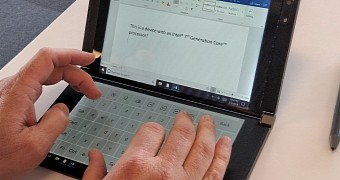Microsoft is reportedly working on a dual-screen device codenamed Andromeda, and often referred to by Windows 10 Mobile enthusiasts as Surface Phone, and while the company remains tight-lipped on the project, others seem to be pursuing similar ideas.
Case in point is none other than Intel, which is building its very own devices with dual screens. At Computex this week, Intel showcases prototypes that used two displays and electronic paper displays (EPD) connected to each other using a hinge in charge of supporting multiple form factors.
With this approach, these devices can turn from tablet to laptop on the go, while also offering increased screen estate when flat.
Multiple form factors
On Intel’s concepts, the laptop form factor would have one of the displays turned into a keyboard, with feedback to be offered when typing in order to simulate typing on a real keyboard. Furthermore, a project called Tiger Rapids and specifically aimed at digital artists and notetakers, uses a 7.9-inch EPD display with a special texture to simulate regular paper.
This means that the screen not only that is just appropriate for note taking, but it also requires less power, with Intel saying that the device could reach up to 15 hours of battery life per charge.
While these devices are still in their early days, they do confirm that dual-screen PCs are a trend that sooner or later more and more tech companies would embrace.
Microsoft itself is said to be actively investing in a similar project known internally as Andromeda and projected to see daylight sometime this year. Just like Tiger Rapids, Microsoft’s device would come in the form of the Courier concept, letting users take notes, but also be productive just like on a laptop.
At the same time, Dell is also believed to be working on a dual-screen model. Both Microsoft and Dell, however, are planning to run on ARM chips, whereas Intel would bet big on its own processors.

 14 DAY TRIAL //
14 DAY TRIAL //